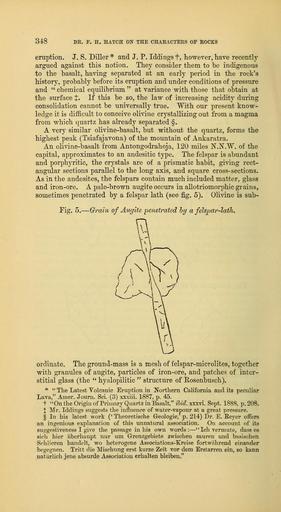MAKE A MEME
View Large Image

| View Original: | The_Quarterly_journal_of_the_Geological_Society_of_London_(13937226491).jpg (1154x2105) | |||
| Download: | Original | Medium | Small | Thumb |
| Courtesy of: | commons.wikimedia.org | More Like This | ||
| Keywords: The Quarterly journal of the Geological Society of London (13937226491).jpg 350 <br> I K E H HATCH ON THE CHAEACTEES OE EOCKS <br> The crystals almost invariably show zonal structure being composed <br> of successive isomorphous layers in which there is a gradually in- <br> creasing difference in chemical composition directly influencing the <br> position of the axes of elasticity the extinction between crossed <br> nicols is consequently not uniform ; it takes the form of a dark <br> shadow which on rotation of the section moves from the centre <br> outwards towards the periphery In one instance a difference of as <br> much as 20° was measured between the peripheral layer and the <br> central portion Even in ordinary light a difference between the <br> peripheral and central portions can sometimes be distinguished <br> the former being of a deeper tint than the latter In sections <br> parallel to the vertical axis the central portion often simulates the <br> shape of an hour-glass see fig 6 This structure has been <br> explained in the following way ” During the consolidation of the <br> rock the augite first separates in skeleton-crystals of the shape of <br> an hour-glass Later on the depressions in the sides of these become <br> filled in by augitic material of a slightly different composition and <br> possessing in consequence an optical character deviating from that of <br> the first-formed central portion A curious instance of zoning in <br> augite is shown in fig 8 Twinning parallel to the orthopinacoid <br> Fig 6 ” Hour-glass Fig 7 ” Augite with <br> structure in Augite glass-inclusion <br> Fig 8 ” Zoned Augite <br> i <br> r <br> is of frequent occurrence In some cases this is polysynthetic <br> as in triclinic felspar see fig 9 ; in one case two twins are united <br> along a common face fig 10 <br> Among the earliest minerals to separate were the hornblende and <br> mica Of these minerals however the major portion has undergone <br> resorption into the molten magma during the later stages of consoli- <br> dation In some cases there remain small fragments encircled <br> by a broad zone of the products of fusion Schmelzzone In <br> the case of the hornblende this secondary material usually retains <br> perfectly the original form of the crystals after which it is pseudo- <br> morphous It consists of 1 opaque particles magnetite ; 2 doubly 36940163 113696 51125 Page 348 Text 45 http //www biodiversitylibrary org/page/36940163 1889 Geological Society of London Biodiversity Heritage Library The Quarterly journal of the Geological Society of London v 45 1889 Geology Periodicals Smithsonian Libraries bhl page 36940163 dc identifier http //biodiversitylibrary org/page/36940163 smithsonian libraries Information field Flickr posted date ISOdate 2014-04-21 Check categories 2015 August 26 CC-BY-2 0 BioDivLibrary https //flickr com/photos/61021753 N02/13937226491 2015-08-26 05 54 56 cc-by-2 0 PD-old-70-1923 The Quarterly journal of the Geological Society of London 1889 Photos uploaded from Flickr by Fæ using a script | ||||